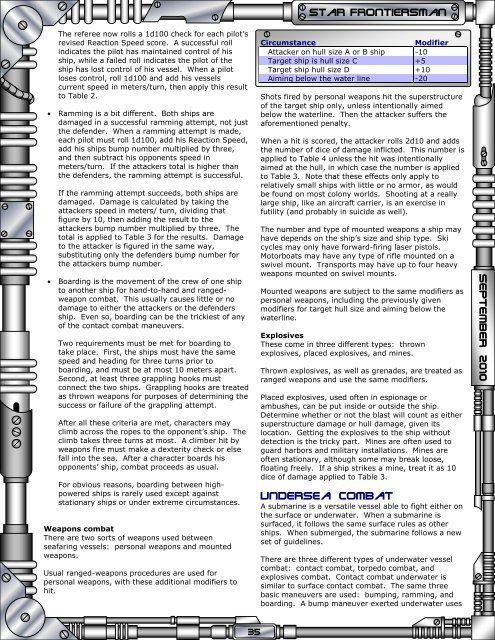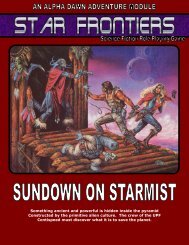September 2010 - Star Frontiersman
September 2010 - Star Frontiersman
September 2010 - Star Frontiersman
Create successful ePaper yourself
Turn your PDF publications into a flip-book with our unique Google optimized e-Paper software.
The referee now rolls a 1d100 check for each pilot’s<br />
revised Reaction Speed score. A successful roll<br />
indicates the pilot has maintained control of his<br />
ship, while a failed roll indicates the pilot of the<br />
ship has lost control of his vessel. When a pilot<br />
loses control, roll 1d100 and add his vessels<br />
current speed in meters/turn, then apply this result<br />
to Table 2.<br />
• Ramming is a bit different. Both ships are<br />
damaged in a successful ramming attempt, not just<br />
the defender. When a ramming attempt is made,<br />
each pilot must roll 1d100, add his Reaction Speed,<br />
add his ships bump number multiplied by three,<br />
and then subtract his opponents speed in<br />
meters/turn. If the attackers total is higher than<br />
the defenders, the ramming attempt is successful.<br />
If the ramming attempt succeeds, both ships are<br />
damaged. Damage is calculated by taking the<br />
attackers speed in meters/ turn, dividing that<br />
figure by 10, then adding the result to the<br />
attackers bump number multiplied by three. The<br />
total is applied to Table 3 for the results. Damage<br />
to the attacker is figured in the same way,<br />
substituting only the defenders bump number for<br />
the attackers bump number.<br />
• Boarding is the movement of the crew of one ship<br />
to another ship for hand-to-hand and rangedweapon<br />
combat. This usually causes little or no<br />
damage to either the attackers or the defenders<br />
ship. Even so, boarding can be the trickiest of any<br />
of the contact combat maneuvers.<br />
Two requirements must be met for boarding to<br />
take place. First, the ships must have the same<br />
speed and heading for three turns prior to<br />
boarding, and must be at most 10 meters apart.<br />
Second, at least three grappling hooks must<br />
connect the two ships. Grappling hooks are treated<br />
as thrown weapons for purposes of determining the<br />
success or failure of the grappling attempt.<br />
After all these criteria are met, characters may<br />
climb across the ropes to the opponent’s ship. The<br />
climb takes three turns at most. A climber hit by<br />
weapons fire must make a dexterity check or else<br />
fall into the sea. After a character boards his<br />
opponents’ ship, combat proceeds as usual.<br />
For obvious reasons, boarding between highpowered<br />
ships is rarely used except against<br />
stationary ships or under extreme circumstances.<br />
Weapons combat<br />
There are two sorts of weapons used between<br />
seafaring vessels: personal weapons and mounted<br />
weapons.<br />
Usual ranged-weapons procedures are used for<br />
personal weapons, with these additional modifiers to<br />
hit.<br />
35<br />
<strong>Star</strong> <strong>Frontiersman</strong><br />
Circumstance Modifier<br />
Attacker on hull size A or B ship -10<br />
Target ship is hull size C +5<br />
Target ship hull size D +10<br />
Aiming below the water line -20<br />
Shots fired by personal weapons hit the superstructure<br />
of the target ship only, unless intentionally aimed<br />
below the waterline. Then the attacker suffers the<br />
aforementioned penalty.<br />
When a hit is scored, the attacker rolls 2d10 and adds<br />
the number of dice of damage inflicted. This number is<br />
applied to Table 4 unless the hit was intentionally<br />
aimed at the hull, in which case the number is applied<br />
to Table 3. Note that these effects only apply to<br />
relatively small ships with little or no armor, as would<br />
be found on most colony worlds. Shooting at a really<br />
large ship, like an aircraft carrier, is an exercise in<br />
futility (and probably in suicide as well).<br />
The number and type of mounted weapons a ship may<br />
have depends on the ship’s size and ship type. Ski<br />
cycles may only have forward-firing laser pistols.<br />
Motorboats may have any type of rifle mounted on a<br />
swivel mount. Transports may have up to four heavy<br />
weapons mounted on swivel mounts.<br />
Mounted weapons are subject to the same modifiers as<br />
personal weapons, including the previously given<br />
modifiers for target hull size and aiming below the<br />
waterline.<br />
Explosives<br />
These come in three different types: thrown<br />
explosives, placed explosives, and mines.<br />
Thrown explosives, as well as grenades, are treated as<br />
ranged weapons and use the same modifiers.<br />
Placed explosives, used often in espionage or<br />
ambushes, can be put inside or outside the ship.<br />
Determine whether or not the blast will count as either<br />
superstructure damage or hull damage, given its<br />
location. Getting the explosives to the ship without<br />
detection is the tricky part. Mines are often used to<br />
guard harbors and military installations. Mines are<br />
often stationary, although some may break loose,<br />
floating freely. If a ship strikes a mine, treat it as 10<br />
dice of damage applied to Table 3.<br />
Undersea combat<br />
A submarine is a versatile vessel able to fight either on<br />
the surface or underwater. When a submarine is<br />
surfaced, it follows the same surface rules as other<br />
ships. When submerged, the submarine follows a new<br />
set of guidelines.<br />
There are three different types of underwater vessel<br />
combat: contact combat, torpedo combat, and<br />
explosives combat. Contact combat underwater is<br />
similar to surface contact combat. The same three<br />
basic maneuvers are used: bumping, ramming, and<br />
boarding. A bump maneuver exerted underwater uses<br />
<strong>September</strong> <strong>2010</strong>
















